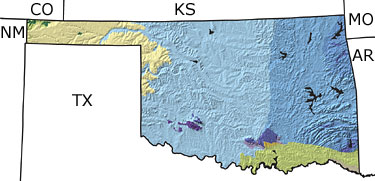

Oklahoma, US |
|||||||||||||||||||||||||||||||||||||||||||||||||||||||||||||||
|
|||||||||||||||||||||||||||||||||||||||||||||||||||||||||||||||
Paleontology and geologyThe Precambrian: Precambrian igneous and metamorphic rocks underlie the entire state; however, a single exposure of igneous rocks occurs in the Arbuckle Mountains of south-central Oklahoma. No fossils are known from any of these rocks. The Paleozoic: A shallow sea covered all of Oklahoma during much of the Early and Middle Paleozoic (Cambrian through Devonian). Brachiopods, trilobites, molluscs, and crinoids thrived in the warm waters. Late in the Paleozoic (Carboniferous), vast deltas were deposited by rivers flowing across the state. The swampy landscape produced rich growths of vegetation that would later become coal seams. Periodically, the sea flooded in across the deltas, returning marine environments to the state. This alternation of marine and non-marine conditions resulted in a cyclic pattern of sedimentary rocks called cylclothems. Near the end of the Paleozoic, the shallow sea retreated across the western part of the state, and thick layers of gypsum and salt were deposited. Rare fossils of insects, amphibians and reptiles, as well as vertebrate footprints, have been collected from latest Paleozoic rocks in Oklahoma. The Mesozoic: Oklahoma lay above sea level for most of the Mesozoic. River and floodplain deposits in the western panhandle contain dinosaur footprints and fossils, crocodiles, turtles, and fish. During the Late Mesozoic (Cretaceous), shallow seas returned to cover much of western and southeastern Oklahoma. Fossils from these marine deposits include oysters, ammonites, and, less commonly, sand dollars (echinoids) and shark teeth. Early Cretaceous terrestrial deposits contain the bones of both carnivorous and herbivorous dinosaurs. The Cenozoic: During the Early Cenozoic (Tertiary), the Rockies were being pushed up to the west, causing a period of broad gentle uplift in Oklahoma and surrounding areas. However, Oklahoma land surface remained lower than the land to the west, and rivers draining off the rising mountains carried extensive sand and gravel deposits into the state. Mammal fossils have been found in some of these deposits, as well as in river sediments which also contain petrified wood. The Late Cenozoic (Quaternary) is primarily a time of erosion in Oklahoma, but river-deposited sediments occur in the far southeastern part of the state. Fossils of wood, clams, snails, and the teeth and bones of horses, camels, bison, and mammoths can be found in these sediments. |
|||||||||||||||||||||||||||||||||||||||||||||||||||||||||||||||
Links to more on Oklahoma paleontology |
|||||||||||||||||||||||||||||||||||||||||||||||||||||||||||||||
|
Education and Exhibits | Research and Collections Education and ExhibitsResearch and Collections
|
|||||||||||||||||||||||||||||||||||||||||||||||||||||||||||||||
|
site tour |
about the site |
site map |
site credits |
page credits |
help |
FAQs |
contact |
||

